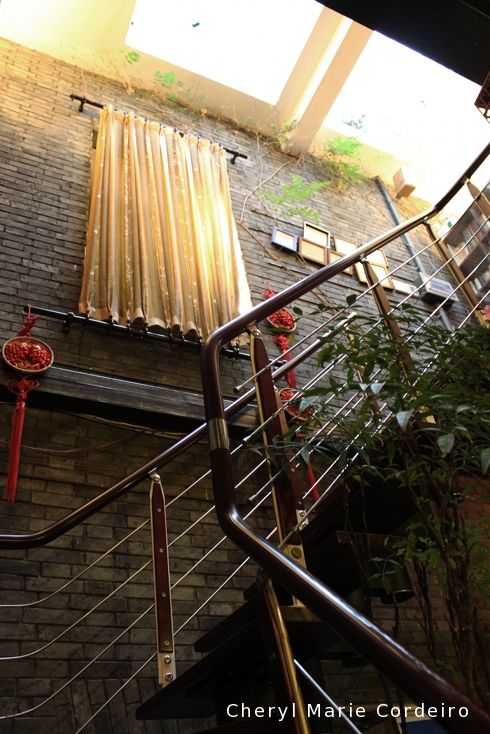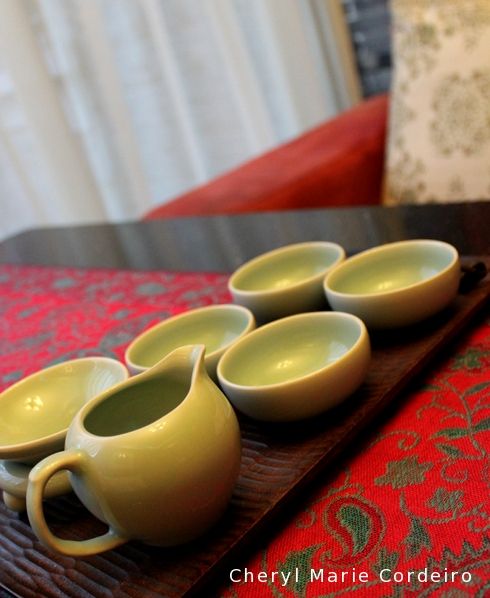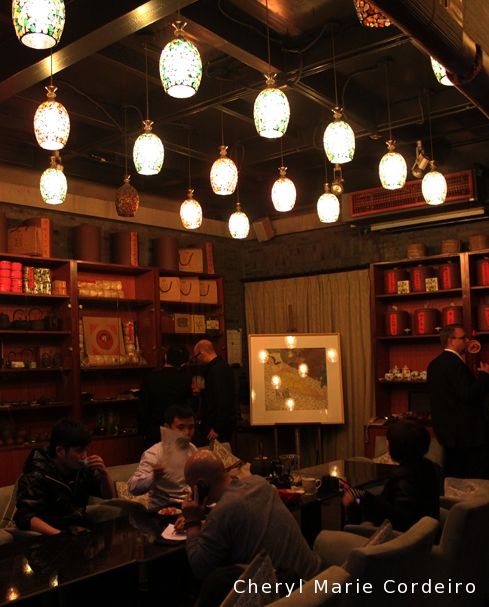
Teahouse. 高山流水.
Tea-drinking at teahouses is a tradition in China that goes back to the Three Kingdoms of Wei, Wu and Shu, 220-280 AD.
Text & Photo © JE Nilsson, CM Cordeiro 2010-2013
Walking through the streets of Hangzhou, I could never quite grasp the sentimental feelings of its romantic past even as my eye caught the elegant lines of temples, the fine pagodas and the many intricately carved bridges that made the landscape so picturesque.
But arrive at the calm and mirroring waters of West Lake, and the realization sets in – that the city through numerous phases of transformations, carries within its aura a purity of natural beauty and a sense of timelessness. And it is perhaps this, that rocked the souls of the literati both past and present.

Carved rosewood in a pattern built around the Chinese symbol of wan – ’endless’ – and ’Buddha’s heart’.
For today’s citizens both in China and abroad, the administrative center Beijing and the business metropolis Shanghai in the south are probably higher up in the day to day awareness. However it has not always been like that.

Set of bowls, in the region’s quintessential and traditional celadon coloured glaze. Celadon ware goes back to the local former Kingdom of Wuyue that sent these ceramics to the Chinese court in the 10th century AD, from right here.
Not further back in history than a mere 900 years ago, China faced a terrifying threat from the north. Invading barbarians – the Jurchen tartars – threatened the then ruling Song dynasty so much that they in 1127 were forced to give up the northern half of China and move the capital and the entire administration to a new city, which was Hangzhou. Here the talents mixed with the successful traditions from Hangzhou (Xifu), that was also the former capital of the Kingdom of Wuyue (907-978).
The climate and the nature was completely different here in the South and this led to the financial burgeoning of the entire region and the cultural revitalization of the entire dynasty. There is no end to how important this relocation was for the arts and crafts. To some extent we can say that even today’s financial importance of China and definitely the south of China have this relocation to thank for its overall success.
During the Qing Dynasty, Hangzhou was one of the top commercial centers for handicraft production in China due to its location at the southern terminus of the Grand Canal. The city had a central role in silk proudction and had long before modernity, been the focal point of high culture and literature. Around the West Lake a cultural tradition of poetry, painting and calligraphy was fostered, all revolving around the delicate landscape of the lake area just outside the city walls.
Chinese literature from the Tang (618-907) and Song (960-1279) periods continue to influence modern Chinese writers. The lake was such an important focal point of cultural politics that during the seventeenth and eighteenth century, the Qing emperors Kangxi (1661-1722) and Qianlong (1736-1795) both frequented the area during their visits for the purpose of coopting the Han Chinese elite in Jiangnan.
The commercial success of the region also offered an alternative outlet for arts and crafts that was not regulated by conservative or stifling Imperial decrees. In the midst of all this, poetry and paintings flowered as did an advancing ceramic industry and amidst this, a culture around the preparation and drinking of tea.

Porcelain ’gaiwan’ tea cups from the nearby Jingdezhen, and Yixing ’purple clay’ teapots, celebrated for their excellent properties for making tea.
Today teahouses along the West Lake in Hangzhou are noted for being secluded and quiet. Simple and unadorned, these teahouses are deemed closer to the spiritual properties of the Chinese tea-drinking ceremony. Seasonal tea sheds in parks are also common up north of the West Lake, where Lotuses bloom. Almond tea, mashed peas and Dongpo Pork (attributed to Song Dynasty artist and poet Su DongPo) are also served.

Groundfloor lounge in a library of tea sorts.
The study of tea cultivation, picking and processing has a long history of scholarship. The most noted work is by LuTong. So passionate was he about tea that his letter of thanks to a friend survives in Chinese literature till today, called the LuTong’s Seven Bowls of Tea:
”The first bowl moistens my lips and throat
The second bowl brings me out of solitary nauseousness
The third bowl searches my barren soul but finds therein some five thousand scrolls
The fourth bowl brings out light perspiration that disperses from my skin life’s troubling affairs
The fifth bowl purifies my flesh and bones
The sixth bowl calls me to the immortals
The seventh bowl I refrain from drinking, else in a light breeze take flight with wings into paradise
Back to Penglai Mountain, where the child in Yuchuanzi wishes to be”
– Poet LuTong (also Yuchuanzi), in a message of thanks to Advisory Official Meng Jian for the gift of new tea. Tang Dynasty, ca. 700 AD

To entice the senses.
An alternative translation to LuTong’s Seven Bowls of Tea can be found via the Lu-Yu Tea Culture Institute:
The first bowl moistens my lips and throat;
The second bowl breaks my loneliness;
The third bowl searches my barren entrails but to find
Therein some five thousand scrolls;
The fourth bowl raises a slight perspiration
And all life’s inequities pass out through my pores;
The fifth bowl purifies my flesh and bones;
The sixth bowl calls me to the immortals.
The seventh bowl could not be drunk, only the breath of the cool wind raises in my sleeves.
Where is Penglai Island, Yuchuanzi wishes to ride on this sweet breeze and go back.
– LuTong (Tang. 790~835)
“Chinese-English Tea Studies Terminology”, (2010), Lu-Yu Tea Culture Institute, Co., Ltd, ISBN978-957-9690-06-5
And while the Chinese tea-drinking culture that we know of today took shape mainly from the Tang Dynasty onwards, being in Hangzhou with its exquisite cuisine, some dishes of which date back to more than 400 years, certainly wraps you up in a time different from the modernities taking shape in the city just out of the doorsteps of this teahouse.
A recommended book to read for starters on teahouses in China? Tea and Chinese Culture by Ling Wang 2005, Long River Press.